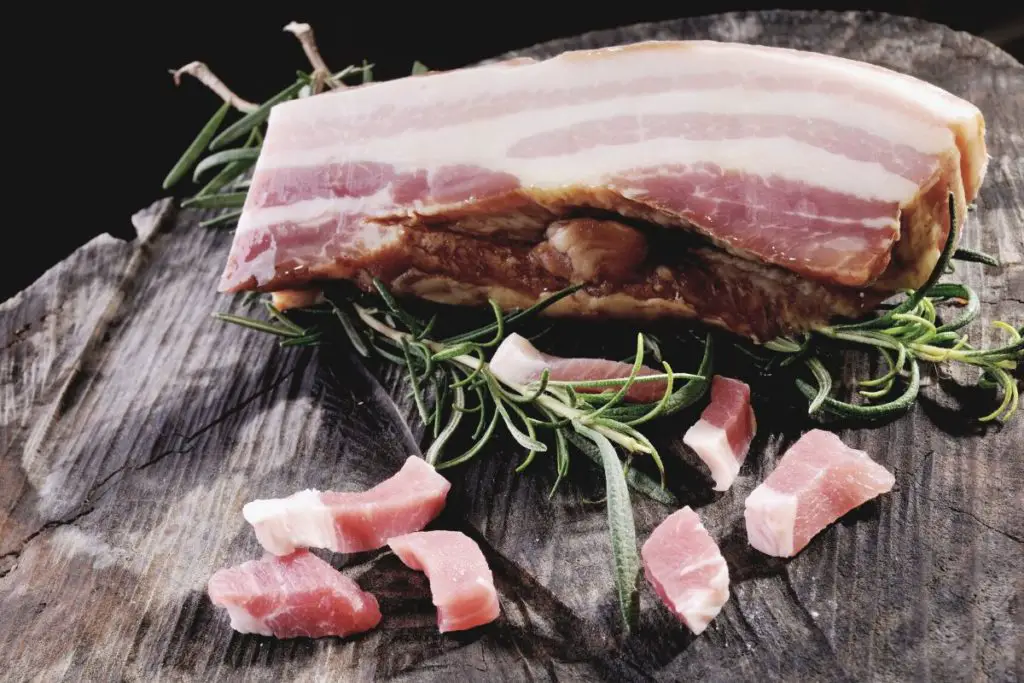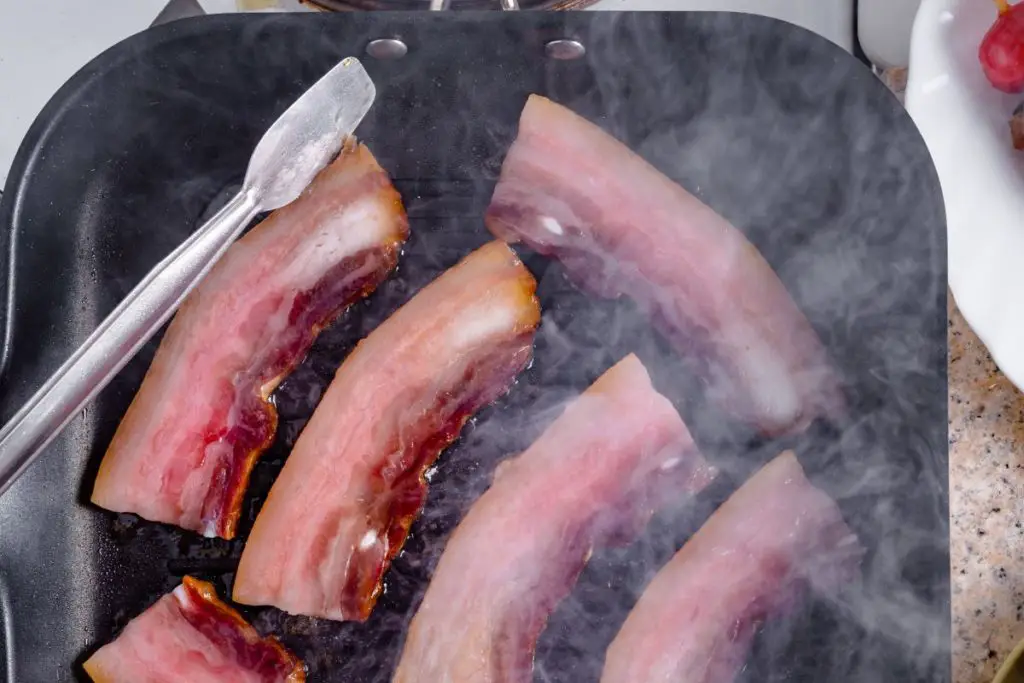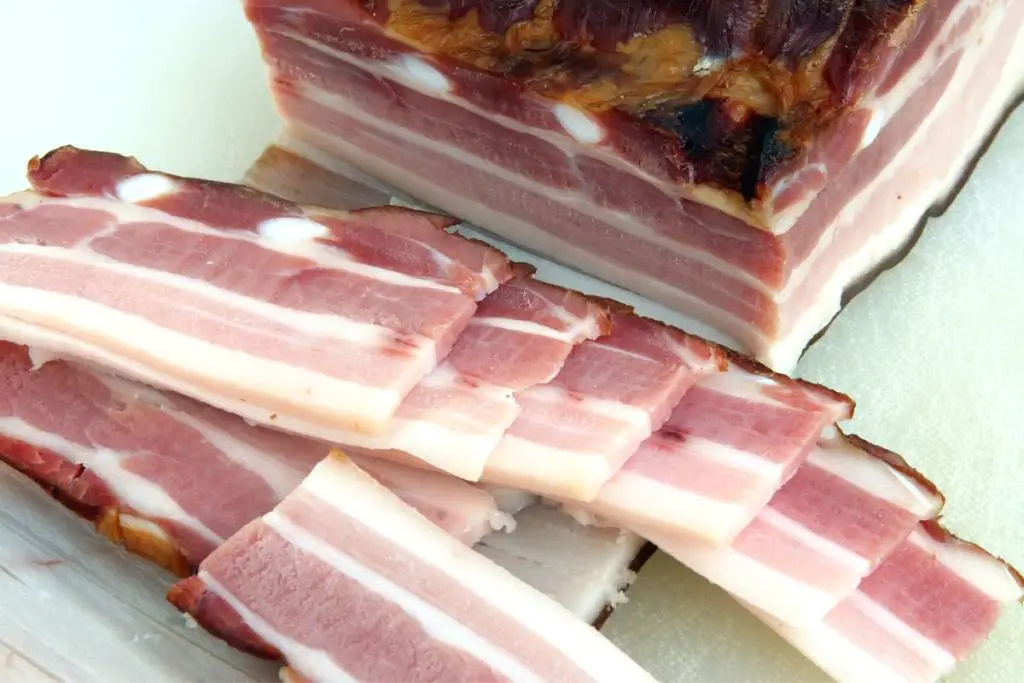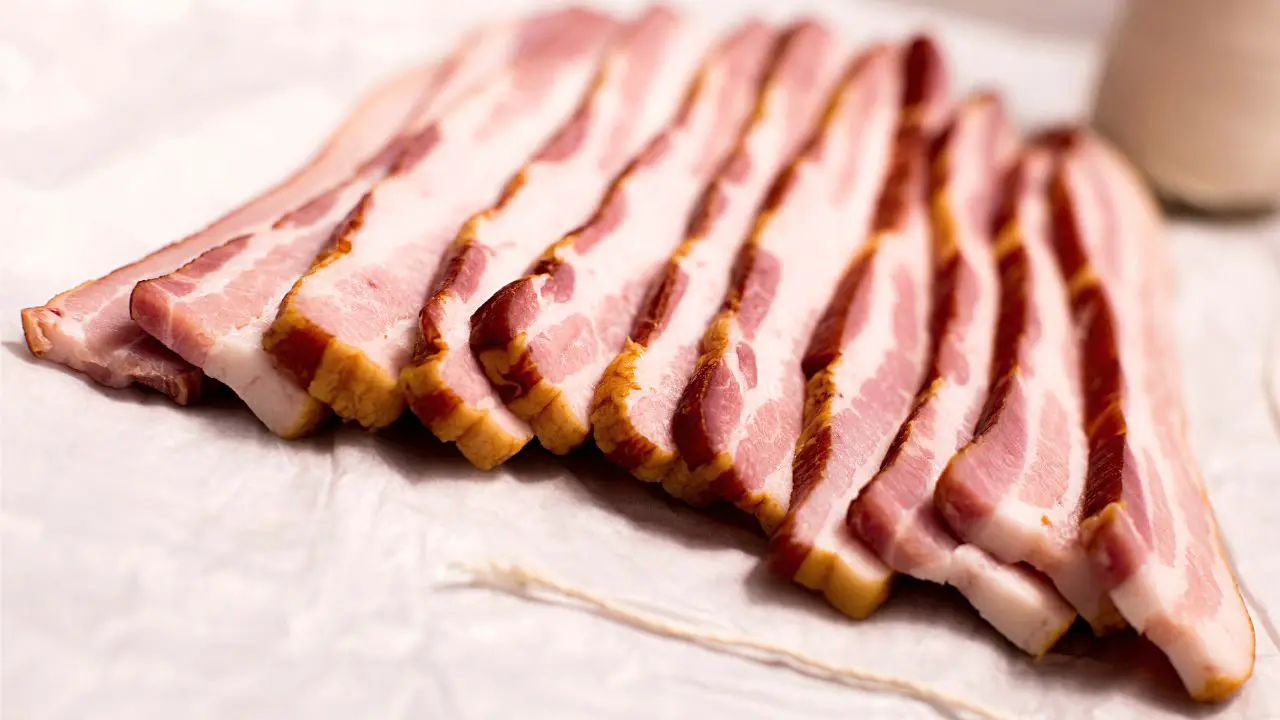Not all bacon is created equal. There’s regular bacon, and then there’s thick-cut bacon. Thicker cut stipes are chewier and often more flavorful because they are thicker and retain more of the smoky, salty flavor when cooked.
Thick-cut bacon is great if you want to slice it into cubes or lardons to add them to pizza, split pea soups, salads, or pasta carbonara. Just cut them into little cubes or matchsticks and fry in a hot pan until crispy and add them to your recipes as you like.

However, thicker-cut salt-cured meat may seem to come with its own little challenges when cooked as stripes.
Here are the four best ways to cook thick-cut bacon.
1. How To Cook Thick-Cut Bacon In The Oven?
Cooking thick-cut bacon in the oven, on this clever DIY aluminum foil rack as I will show you in the video below is one of the best methods to cook bacon. For starters, it works for both, regular, thin-cut, and thick-cut rashers.
Also, it is a hands-off cooking method, so set it and forget it. Since these chunky rashers have a lot of fat, cooking it in the oven on this foil rack allows some of it to drip right off into a bottom of a baking tray.
On the downside, if not cooked long enough, oven-cooked bacon is chewier and softer, and not particularly crispy.
Here is how to cook thick-cut bacon in the oven:
- Preheat the oven to 400°F (205°C).
- Fold the aluminum foil into a one since stripe, as seen in the video above.
- Line a baking tray with an aluminum foil rack.
- Place the bacon on a rack.
- Cook for 20-30 minutes to the desired crispiness.
Top Tip: To get the meat and fat in your bacon to cook evenly, they must be at approximately the same temperature. Staying cold for longer than the meat, leave the bacon at room temp for about 20 minutes before cooking for evenly cooked crispy rashers.
2. How to Cook Thick-Cut Bacon on a Stove?

To cook thick-cut bacon on the stove-top, place the strips on a cold non-stick frying pan and cook over medium heat — don’t add oil, as the thicker cuts come with their own fat and lots of it. Cooking the bacon low and slow allows the fat to render slowly, guaranteeing an even cooking and crispier rashers.
Do not over-crowd the pan; work in batches if necessary and flip the bacon regularly. Carefully discard any excess fat accumulating in the pan. Cook for 10-15 minutes to the desired crispness and increase the temperature as you go to finish the bacon over a high flame.
Top Tip: If you don’t have a non-stick frying pan, you can also use a cast-iron skillet. The well-seasoned coating will prevent your bacon from sticking to the surface, providing an extra flavor layer that will be simply irresistible.
3. How to Cook Thick-Cut Bacon in an Air Fryer?
Air fryers are fantastic appliances that can crisp anything with little to no oil in just a few minutes. The secret is in a jet of hot air circulating around the food, and yes, you can air-fry bacon. Keep in mind all air fryers are different, so read your instruction manual — some manufacturers aren’t recommending air-frying greasy food.
Having said that, with a standard air fryer, place the bacon in the basket without overlapping and air fry for between 8-10 minutes, at a temperature between 375°F and 390°F (190°C and 200°C). Again, all appliances are different.
For a less greasy result, place the bacon on paper towels right after removing it from the air fryer basket.
Top Tip: To get more event-cooked rashers, shake the basket halfway through, or flip the slices over with metal tongs at least once every 3-4 minutes. Doing this will ensure your thick-cut bacon slices get an even amount of heat on each side, leading to a crispy surface and succulent inside.
4. How to Cook Thick-Cut Bacon in the Microwave?

Microwaved bacon is actually ok, and it is neither too crispy nor too rubbery — if that is the only way to cook it then you can make it work. Of course, cooking thick-cut bacon is a bit trickier than nuking regular bacon strips. For this one, we need extra padding.
Place 3-4 paper towels over a microwave-safe plate and place the thick-cut bacon strips over the paper — do not overlap. Place an extra paper towel over the bacon to prevent splatter, and microwave on high for 6-8 minutes. For crispier bacon, you might need a few additional minutes without the top paper layer.
Read Also: Is There An Air Fryer Microwave Combo? Yes, Here Are The 5 Best Ones!
Top Tip: Each microwave yields heat differently, so trial and error will help you figure out the best timeframe. Luckily, thick-cut bacon can handle temperature shifts, so you don’t need to worry much. Just make sure to start checking for doneness a minute or two before the end of the cycle, as a few seconds could be the difference between crisp and burnt.
Frequently Asked Questions

How Thick Is Thick-Cut Bacon?
On average, bacon is considered to be a thick-cut when the slice is thicker than 1/8 of an inch (0.3 cm), compared to the standard thickness of regular bacon, which sits at 1/16 inches (0.15 cm)—twice as thick.
Does Thick-Cut Bacon Get Crispy?
Due to its size, odds are you won’t get thick-cut bacon to turn crispy to the point of being brittle. Regular, thinner bacon reaches that crisp point by losing most of its fat and moisture, and thicker cuts always retain some of it right in the middle.
But while you’ll never get that point of crispiness with thick bacon, it’s perfectly possible to cook it in a manner that makes the outsides and edges crispy and crunchy while the center remains still slightly chewy.
Is Thick-Cut Bacon Better?
Whether or not thick-cut bacon is better is a matter of taste and the recipe you using it for. However, thicker slices carry more flavor due to their meatier texture, which means they may feel more substantial to the palate. Likewise, their bigger surface area gives them a more enhanced smoked taste.
Thick-cut bacon cuts well and allows you to slice it into cubes or lardons to include in macaroni dishes, pasta carbonara, split pea soups, or even salads.
On the other hand, thick-cut bacon also has higher sodium and fat levels, making them slightly unhealthier than the thinner alternatives.
What Is The Best Thick-Cut Bacon?
The best thick-cut bacon will be the one that is as thick as it advertises, has a healthy balance of fat and meat content, and has the perfect flavor combination of smoky, savory, and slightly salty.
Some well-loved brands include Benton’s Hickory Smoked Country Bacon, Peter Luger Extra Thick Cut, or Edwards Sliced Hickory-Smoked Peppered Bacon.
How To Cook Extra Thick, Triple Thick Cut, Or Bacon Steak?
Extra-thick, triple-thick, and bacon steak cuts follow the same basic cooking method, regardless of your preferred medium. Each requires medium-to-low heat and extended periods, regularly turning on each side to brown evenly.
If using the oven or a deep fryer, the temperatures range from 370°F to 400°F (188°C-205°C) and require a bare minimum of 10 minutes.
How To Tell When Thick Cut Bacon Is Done?
Much like any other type of bacon, thick-cut rashers are done when their color changes from light pink to a darker brown. Likewise, it should have a slightly crisp edge, and the fat stripes should begin to melt and shrink in size.
Beyond that, you can keep cooking thick-cut bacon to suit your tastes. Due to its thicker size, you should let it sit at a lower temperature for a bit longer, but it is perfectly fine to eat while still chewy, as long as the other signs of doneness remain visible.
What Is Slab Bacon?
Slab bacon is a slab or block of cured and smoked pork belly that has not been cut into strips yet. It is often sold in butcher shops and grocery stores. Slab bacon is the perfect choice for those who like to cut their own rashers. It can be cut into ultra-thin strips or as thick as you prefer.
In Summary
There’s you have it! That’s how you cook thick-cut bacon four ways. Now, if you’re cooking for a crowd and need to cook large quantities of bacon, here are three methods that work every time.
Cured and smoked bacon is a noble ingredient, cooked on its own or in the recipes, and goes absolutely perfect with moist and fluffy scrambled eggs on your breakfast table, as long as you don’t overdo it. Let’s cook bacon the right way and enjoy the meaty, fatty, crispy treat!

